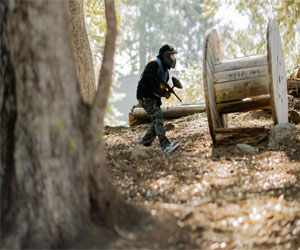


Embracing The Thrill Of The Trail

Mountain biking is a sport that thrives on exhilaration, with heart-pounding experiences that leave riders craving more. From navigating challenging terrains to conquering steep descents, mountain biking offers an adrenaline rush like no other. It's a sport where riders can push their limits, embrace the thrill, and find themselves in heart-pounding moments that become unforgettable memories.
The heart-pounding experiences in mountain biking often begin with the sheer unpredictability of the trail. Unlike the smooth, well-paved roads of traditional cycling, mountain biking trails present riders with a dynamic range of obstacles. From rocky paths and tight switchbacks to steep drops and roots to navigate, the excitement lies in the unpredictability of each ride. It's this element of surprise that keeps the heart racing and the senses heightened.
One of the most thrilling aspects of mountain biking is conquering challenging terrains. Riders push themselves to their limits, testing their endurance and technical prowess. The climb up a steep hill can be grueling, but the sense of accomplishment at the summit is unparalleled. Descending down a rocky slope with precision and control is a heart-pounding experience that combines fear and excitement, often resulting in an adrenaline high.
Steep descents, in particular, are a hallmark of heart-pounding mountain biking. These exhilarating moments put riders on the edge of their seats as they negotiate sharp declines, often featuring rocks, drops, and obstacles. The focus required to maintain control while descending at high speeds is intense, making it a heart-pounding adventure that demands unwavering concentration.
Another heart-pounding element of mountain biking is taking on technical features like jumps and drop-offs. These challenges require riders to become airborne, adding an element of thrill and danger. The rush of adrenaline that comes from launching off a jump and successfully landing is a sensation that many riders chase and savor.
Heart-pounding experiences are not limited to descents or technical features. Riding at high speeds through narrow singletrack trails, navigating tight corners, and surmounting obstacles all contribute to the thrill of mountain biking. It's the combination of skill, balance, and daring that makes every ride an adventure.
Safety remains paramount in the world of heart-pounding mountain biking. Riders should always wear appropriate protective gear, including helmets, gloves, and body armor. The bike's brakes and suspension should be in excellent working condition to ensure control on challenging descents and technical features. Moreover, practicing proper body positioning, weight distribution, and obstacle negotiation techniques is essential to maintain safety on the trail.
Heart-pounding mountain biking experiences are the beating heart of the sport. Riders are drawn to the thrill of conquering challenging terrains, navigating steep descents, and mastering technical features that test their skills and courage. Safety, preparation, and a deep love for adventure are key components of these heart-pounding moments. Whether you're an experienced rider seeking to push your boundaries or a beginner eager to explore the thrill of the trail, mountain biking provides an avenue to embrace heart-pounding adventures that are bound to leave you craving more. So, gear up, hit the trails, and immerse yourself in the world of heart-pounding mountain biking where every ride is an adrenaline-pumping experience.
A Fascinating Journey Into Nature's Avian Realm
 The Appeal Of Birdwatching:
The Appeal Of Birdwatching:
Birdwatching's enduring popularity can be attributed to its multifaceted appeal:
A Connection With Nature: Birdwatching provides a direct and intimate connection with the natural world. It invites enthusiasts to step outdoors and immerse themselves in the sights and sounds of diverse ecosystems, from lush forests to coastal wetlands.
Discovery And Exploration: Each birdwatching outing is a journey of discovery. Every observation offers the chance to encounter new species, behaviors, and habitats, providing endless opportunities for exploration and learning.
A Sense Of Serenity: Birdwatching is a calming and meditative experience. It allows individuals to escape the hustle and bustle of daily life, fostering a sense of peace and tranquility.
Community And Camaraderie: Birdwatchers often form tight-knit communities, connecting with others who share their passion. Bird clubs, online forums, and group outings provide opportunities for shared experiences and the exchange of knowledge.
Scientific Contribution: Birdwatching isn't just a hobby; it's a valuable scientific pursuit. Enthusiasts contribute to citizen science projects, gathering data on bird populations, behaviors, and migrations that aid in ornithological research and conservation efforts.
Pickleball Court Dynamics
 The Non-Volley Zone: Also known as "the kitchen," this is a crucial area on the court that extends 7 feet from the net on each side. The kitchen is a no-volley zone, meaning that players cannot hit the ball out of the air within this zone. This rule encourages strategic play, as players must carefully position themselves to avoid faulting.
The Non-Volley Zone: Also known as "the kitchen," this is a crucial area on the court that extends 7 feet from the net on each side. The kitchen is a no-volley zone, meaning that players cannot hit the ball out of the air within this zone. This rule encourages strategic play, as players must carefully position themselves to avoid faulting.
The Baseline: The back line of the court is where serves must originate. Players serve from behind this line, and the serve must clear the non-volley zone on the opposite side of the court. The baseline is a key starting point for each point and plays a role in determining the position of the serving team.
The Net: The pickleball net stands 34 inches at the center, which is lower than traditional tennis or badminton nets. The lower net height demands precise and controlled shots, particularly during the serve and volleys near the net.
Serving Boxes: Each side of the court is divided into two serving boxes. The serving team must serve diagonally into the opponent's service box, following specific serving rules. The diagonal serves create unique angles and placement opportunities, adding to the dynamic court dynamics.
Doubles vs. Singles: Pickleball is typically played in both doubles and singles formats, with different strategies and court dynamics in each. In doubles, players work as a team, cover the court together, and employ coordinated strategies.
Keys To Victory On The Battlefield
 2. Cover And Suppression
2. Cover And Suppression
Suppression and providing cover fire are vital elements in winning paintball games. By keeping your opponents' heads down and restricting their movements, you can create opportunities for your team to advance, secure objectives, or take advantageous positions. Supporting your teammates with covering fire allows them to maneuver more effectively.
3. Flanking Maneuvers
Outflanking your opponents is a classic and effective paintball strategy. By taking a wide route to the side or rear, you can catch your opponents in a crossfire and disrupt their plans. Flanking maneuvers can be especially powerful when combined with effective communication and coordination.
4. Defense And Control
In certain scenarios, adopting a defensive approach can be a winning strategy. Defend critical areas, objectives, or positions to maintain control and prevent the opposing team from advancing. Defensive play requires patience, excellent marksmanship, and teamwork to hold your ground.
5. Adaptability And Flexibility
Paintball games can be unpredictable, and the ability to adapt and be flexible in your strategies is a key element in achieving victory. Stay open to changing tactics as the game evolves. What worked in one round may not work in the next, so being willing to adjust is crucial.
6. Teamwork And Roles
Teamwork is an integral part of winning paintball games. Within your team, define roles based on each player's strengths and preferences. Roles can include snipers, assault players, defenders, and more. When these roles are strategically combined, they can be highly effective in achieving objectives and eliminating opponents.
7. Map Awareness
Familiarity with the paintball field's layout is essential. Knowing the terrain, hiding spots, and potential ambush locations can give you a significant edge. By understanding the map, you can predict enemy movements and plan your strategies accordingly.






Surfing Competitions And Events
 Variety Of Competitions:
Variety Of Competitions:
Surfing competitions come in various forms, catering to a wide range of surfers and preferences. Some of the most notable include:
Professional Surfing Tours: The World Surf League (WSL) is the pinnacle of professional surfing. It hosts a series of events around the world, including the prestigious Championship Tour (CT), where elite surfers compete for the world title. The tour features both men's and women's divisions, showcasing the best surfers on the planet.
Amateur And Junior Competitions: These events are open to up-and-coming surfers and groms (young surfers). They provide a platform for emerging talent to gain experience and recognition in the surfing world.
Big Wave Contests: These competitions take place in locations known for enormous waves. Events like the Quiksilver in Memory of Eddie Aikau and the Big Wave World Tour celebrate big wave surfing and challenge surfers to ride massive, life-threatening waves.
National And Regional Championships: Many countries and regions hold their own national and regional surfing championships. These contests identify the top surfers in a particular area and serve as a stepping stone to larger competitions.
Judging Criteria:
Surfing competitions are scored based on a set of criteria, with judges assessing each wave ride. The criteria typically include:
Wave Selection: Surfers are judged on their wave selection and positioning in the lineup. Choosing the best waves with good shape and potential for maneuvers is crucial.
A Sport With A Winning Combination
 Accessibility: One of the most significant advantages of pickleball is its accessibility. The game's court dimensions are smaller than those of traditional tennis, making it an ideal choice for people of all ages and physical conditions. Whether you're a child, a senior, or somewhere in between, pickleball offers an inclusive and welcoming environment. The sport accommodates various skill levels and abilities, ensuring that everyone can participate.
Accessibility: One of the most significant advantages of pickleball is its accessibility. The game's court dimensions are smaller than those of traditional tennis, making it an ideal choice for people of all ages and physical conditions. Whether you're a child, a senior, or somewhere in between, pickleball offers an inclusive and welcoming environment. The sport accommodates various skill levels and abilities, ensuring that everyone can participate.
Social Interaction: Pickleball is as much a social activity as it is a sport. The game's format encourages interactions and fosters a sense of camaraderie. Many players join local pickleball clubs, groups, or leagues, providing opportunities to connect with others who share their passion for the sport. The social aspect of pickleball strengthens community ties and often leads to lasting friendships.
Physical Fitness: Playing pickleball is an excellent way to stay physically active and maintain overall health. The sport involves continuous movement, from quick lateral shifts to agile net approaches, which provide a cardiovascular workout and promote agility. Regular play helps improve balance, coordination, and endurance, making it an effective way to enhance one's physical fitness.
Mental Stimulation: Pickleball offers both physical and mental stimulation. Players must strategize, anticipate their opponents' moves, and make split-second decisions. This mental engagement contributes to improved cognitive function and keeps players sharp as they age.
Short Learning Curve: Pickleball has a relatively short learning curve compared to other racket sports. Newcomers can quickly grasp the basic rules and techniques, allowing them to enjoy the game without prolonged training periods. This accessibility and ease of learning make pickleball particularly appealing to beginners.